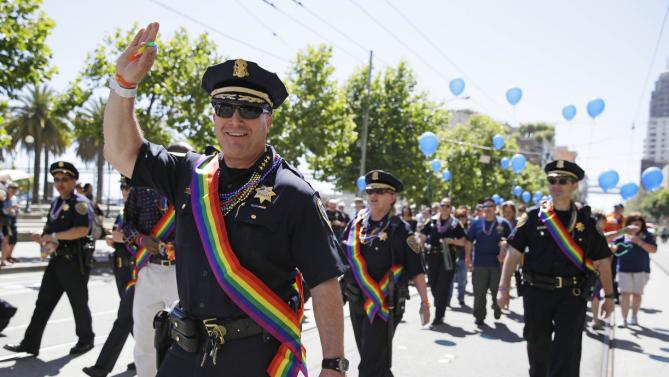Police Participation In Pride
Every year our communities celebrate aspects of diversity and identity in ways that often include a big parade down main street. St. Patrick’s Day, Veteran’s Day, Chinese New Year, and of course, gay pride are all examples of annual celebrations that make visible who we are. These celebrations often include festivals where organizations host information booths, stages for entertainment, and opportunities for people to come together and learn about culture and individual differences. All of these events provide law enforcement with an invaluable opportunity to make visible how different communities are represented within the rank and file of the department as well as how the department supports, as an ally, different cultures and identities. There is a long standing tradition in cities across America that includes law enforcement officers marching in these parades in uniform with pride. So why would a gay pride parade today be any different? If you believe that marching in a parade in a police uniform is a form of representing the police department and the citizens it serves, why would marching in a Chinese New Year parade or St. Patrick’s Day parade be any different than an a gay pride parade? The truth is that there is no difference at all.

It’s logical and likely wise to prohibit law enforcement officers from participating in political marches and events while in uniform. And it’s true that law enforcement needs to maintain a politically neutral position whenever possible. But gay pride parades are not political marches or exclusively political events. They are produced in cooperation with municipalities and often with full support public and private organizations. They are celebrations of our identities (identities that are present in every jurisdiction) in ways very similar to those celebrations of culture and nationality. And just how police departments see benefit in making visible the Chinese members of the department during the Chinese New Year parade, so is the importance of making visible the LGBT personnel in gay pride parades. In fact, I argue that it’s even more important to encourage LGBT personnel to march in uniform in a gay pride parade, because sexual orientation, unlike skin color, is something you cannot see during day-t0-day contacts with citizens. In today’s world, LGBT adults and youth alike need to see themselves represented within the rank and file of law enforcement. Pride parades provide an important and valuable opportunity for progressive law enforcement agencies that value diversity to demonstrate this value in a positive and celebratory way.
So why on earth, in today’s world, would any law enforcement executive deny an LGBT employee the opportunity to march in uniform in a gay pride parade? Why is it that a police chief of a department with a mission statement that includes valuing partnerships, diversity within the community, and treating people fairly, openly discriminate by letting officers march in uniform in one parade, but not another. How could a police chief see a community interest in having law enforcement be visible in a parade celebrating Chinese New Year, but not in one celebrating LGBT pride. Does that chief think that there are no LGBT people in the city? Almost every modern law enforcement agency claims to value teamwork and community, but does this include LGBT people? And what kind of message is sent to the rank and file when Irish officers are allowed to march in uniform in the St. Patrick’s Day parade, but LGBT personnel are denied the opportunity to march in uniform in the gay pride parade. Such denials are huge missteps and missed opportunities that conflict with the above stated values and mission.
Aside from the ethical and professional conflicts involved, denying an employee the ability to march in a gay pride parade in uniform may also be illegal. The California Fair Employment and Housing Act prohibits any employer from engaging in discrimination based on sexual orientation (20 other states have similar prohibitions in place). What this means is that if agency executives have allowed personnel to march in uniform in one parade, denying personnel the opportunity to march in uniform in a gay pride parade is clearly illegal. You would think that this would be common sense for today’s law enforcement executive. In 2011, a officer from the California Department of Corrections and Rehabilitation requested to march in the Los Angeles gay pride parade in uniform. His request was denied because marching in uniform would “discredit” the department. A civil rights attorney advocating for the officer threatened suit under the California law described above and the department quickly reversed its decision favoring compliance with the law.
In states where discrimination based on sexual orientation is prohibited by law, denying an employee the ability to march in uniform in a gay pride parade is illegal and opens the agency executive and government entity to a civil suit. There are plenty of civil rights attorneys that would eagerly take-on a case like this. Worse yet, this kind of denial communicates to employees and the community that LGBT diversity is not valued in the same way as other forms of diversity. It’s a damaging and unacceptable form of homophobia that has no place in today’s law enforcement profession.
Police executives should be proud to have their employees represented in gay pride parades. When an employee comes forward and asks to represent the department and to make themselves visible as a member of the LGBT community or as an ally, the executive should see this request as a great opportunity to bolster relationships with the community, to promote teamwork, and to demonstrate the value of LGBT employees. Participation in pride events is an excellent recruiting opportunity and law enforcement leaders should eagerly embrace the wishes of employees to participate in this kind of community event. We support individual employees and law enforcement agencies who participate in pride events in a very visible way, so get out there and march!
